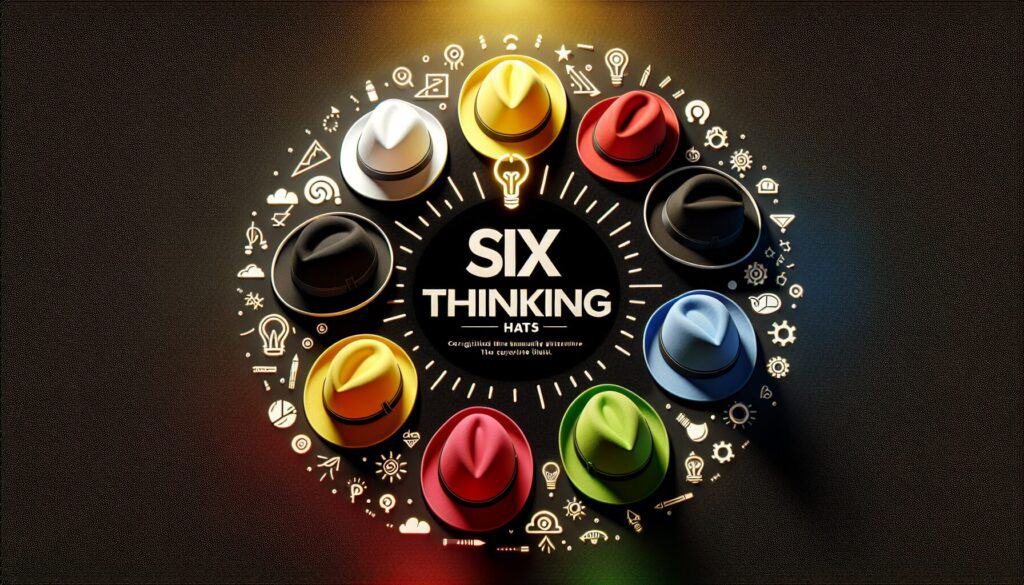A parallel thinking technique developed by Edward de Bono, designed to improve group discussions and decision-making by having participants look at an issue from six distinct perspectives, each represented by a colored “hat”.
- Methodologies: Customers & Marketing, Economics, Product Design
Six Thinking Hats

Six Thinking Hats
- Agile Methodology, Brainstorming, Creativity, Cross-Functional Collaboration, Design Thinking, Innovation, Problem Solving Techniques, Process Improvement, Teamwork
Objective:
How it’s used:
- Participants metaphorically wear different colored hats: White (facts & information), Red (emotions & intuition), Black (caution & critical judgment), Yellow (optimism & benefits), Green (creativity & new ideas), and Blue (process control & overview). The group focuses on one hat at a time.
Pros
- Encourages thorough exploration of a topic from multiple viewpoints; Reduces conflict by separating ego from performance; Fosters focused and productive discussions; Promotes creative thinking and critical evaluation in a structured way.
Cons
- Can feel artificial or overly structured if not facilitated well; Requires discipline from participants to stick to the designated hat; May take time for teams to become proficient in its use.
Categories:
- Ideation, Problem Solving, Product Design, Project Management
Best for:
- Facilitating effective group discussions, exploring different perspectives on an issue systematically, and making more well-rounded decisions.
The Six Thinking Hats methodology can be employed in various industries, including product design, healthcare, education, and corporate strategy, allowing teams to tackle problems or innovate in a structured manner. This approach is particularly effective during brainstorming sessions, project reviews, and product development phases, where collaboration and comprehensive analysis are required. For example, in a design team developing a new consumer electronic device, members might use the White Hat to present market research data on user preferences, switch to the Red Hat to express feelings about design aesthetics, utilize the Black Hat to identify potential manufacturing limitations, and then adopt the Yellow Hat to envision the advantages this product could offer to customers. This technique is often initiated by team leaders or project managers, but it thrives on participation from diverse roles across an organization, including engineers, designers, marketers, and end-users. Its structured nature encourages all participants to contribute their viewpoints without falling into conflicts over personal opinions, as the focus transitions systematically from one aspect to another, fostering an atmosphere of respect and collaboration. Such meetings can lead to more innovative outcomes, as the Green Hat invites out-of-the-box thinking and the exploration of unconventional solutions. Companies that have successfully implemented this methodology report clearer decision-making processes, increased team alignment, and ultimately more robust product offerings that address various stakeholder needs.
Key steps of this methodology
- Introduce the issue to be discussed.
- Wear the White Hat: Focus on facts, data, and information relevant to the topic.
- Wear the Red Hat: Share emotions, intuitions, and gut feelings regarding the issue.
- Wear the Black Hat: Discuss potential risks, obstacles, and negative aspects.
- Wear the Yellow Hat: Explore benefits, advantages, and positive outcomes.
- Wear the Green Hat: Brainstorm creative solutions and new ideas.
- Wear the Blue Hat: Guide the process, summarize discussions, and outline next steps.
Pro Tips
- Rotate the hat order based on the phase of discussion, ensuring fresh perspectives emerge at critical stages.
- Assign specific roles to participants for each hat to enhance engagement and accountability during discussions.
- Document the outputs from each hat systematically to create a comprehensive record for future reference and analysis.
To read and compare several methodologies, we recommend the
> Extensive Methodologies Repository <
together with the 400+ other methodologies.
Your comments on this methodology or additional info are welcome on the comment section below ↓ , so as any engineering-related ideas or links.
Historical Context
1980
1980
1980
1986
1987
1990
1990
1972
1980
1980
1986
1986
1987-03
1990
1990
(if date is unknown or not relevant, e.g. "fluid mechanics", a rounded estimation of its notable emergence is provided)















Related Posts
Monte Carlo Simulation
Model-Based Testing
Model Checking
Mixed Methods Research
Mistake Proofing (Poka-Yoke)
Mission Profile Testing